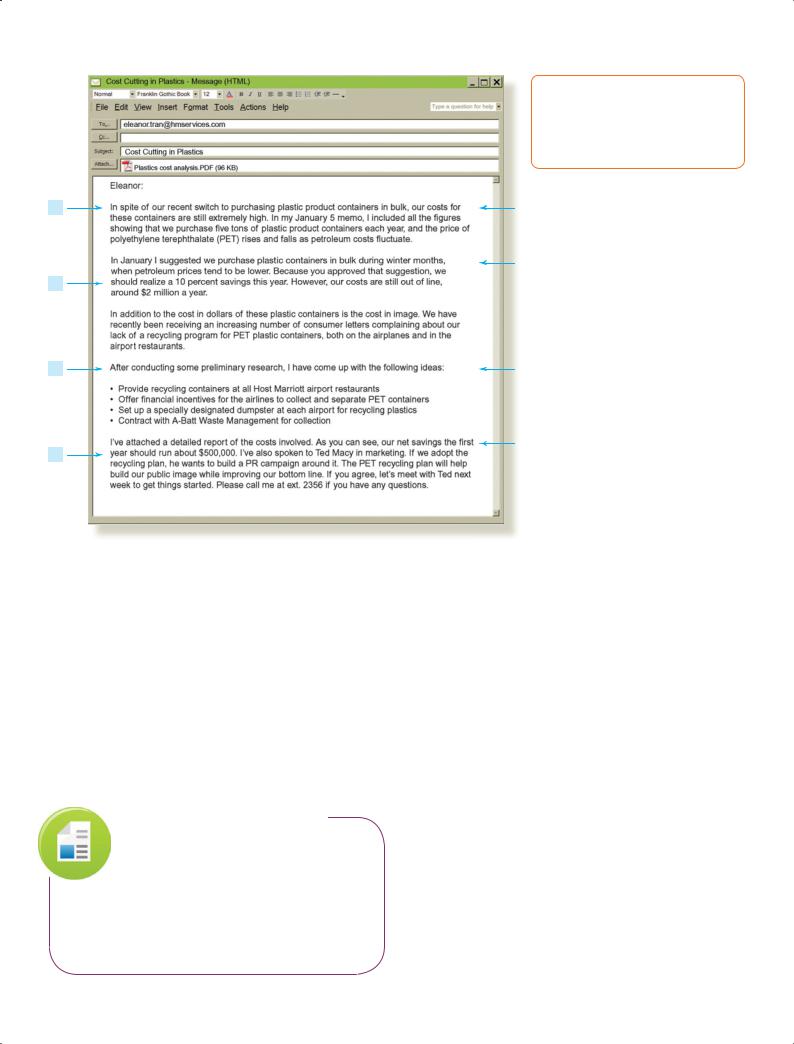
- •Understanding Why Communication Matters
- •Communicating as a Professional
- •Exploring the Communication Process
- •Committing to Ethical Communication
- •Communicating in a World of Diversity
- •Using Technology to Improve Business Communication
- •Chapter Review and Activities
- •Test Your Knowledge
- •Apply Your Knowledge
- •Practice Your Skills
- •Expand Your Skills
- •References
- •Understanding the Three-Step Writing Process
- •Analyzing the Situation
- •Gathering Information
- •Selecting the Right Medium
- •Organizing Your Message
- •Chapter Review and Activities
- •Test Your Knowledge
- •Apply Your Knowledge
- •Practice Your Skills
- •Expand Your Skills
- •References
- •Adapting to Your Audience: Building Strong Relationships
- •Adapting to Your Audience: Controlling Your Style and Tone
- •Composing Your Message: Choosing Powerful Words
- •Composing Your Message: Creating Effective Sentences
- •Composing Your Message: Crafting Coherent Paragraphs
- •Using Technology to Compose and Shape Your Messages
- •Chapter Review and Activities
- •Test Your Knowledge
- •Apply Your Knowledge
- •Practice Your Skills
- •Expand Your Skills
- •References
- •Revising Your Message: Evaluating the First Draft
- •Revising to Improve Readability
- •Editing for Clarity and Conciseness
- •Using Technology to Revise Your Message
- •Producing Your Message
- •Proofreading Your Message
- •Distributing Your Message
- •Chapter Review and Activities
- •Test Your Knowledge
- •Apply Your Knowledge
- •Practice Your Skills
- •Expand Your Skills
- •References
- •Electronic Media for Business Communication
- •Social Networks
- •Information and Media Sharing Sites
- •Instant Messaging and Text Messaging
- •Blogging
- •Podcasting
- •Chapter Review and Activities
- •Test Your Knowledge
- •Apply Your Knowledge
- •Practice Your Skills
- •Expand Your Skills
- •References
- •Strategy for Routine Requests
- •Common Examples of Routine Requests
- •Strategy for Routine Replies and Positive Messages
- •Common Examples of Routine Replies and Positive Messages
- •Chapter Review and Activities
- •Test Your Knowledge
- •Apply Your Knowledge
- •Practice Your Skills
- •Expand Your Skills
- •References
- •Using the Three-Step Writing Process for Negative Messages
- •Using the Direct Approach for Negative Messages
- •Using the Indirect Approach for Negative Messages
- •Sending Negative Messages on Routine Business Matters
- •Sending Negative Employment Messages
- •Sending Negative Organizational News
- •Responding to Negative Information in a Social Media Environment
- •Chapter Review and Activities
- •Test Your Knowledge
- •Apply Your Knowledge
- •Practice Your Skills
- •Expand Your Skills
- •References
- •Using the Three-Step Writing Process for Persuasive Messages
- •Developing Persuasive Business Messages
- •Common Examples of Persuasive Business Messages
- •Developing Marketing and Sales Messages
- •Chapter Review and Activities
- •Test Your Knowledge
- •Apply Your Knowledge
- •Practice Your Skills
- •Expand Your Skills
- •References
- •Applying the Three-Step Writing Process to Reports and Proposals
- •Supporting Your Messages with Reliable Information
- •Conducting Secondary Research
- •Conducting Primary Research
- •Planning Informational Reports
- •Planning Analytical Reports
- •Planning Proposals
- •Chapter Review and Activities
- •Test Your Knowledge
- •Apply Your Knowledge
- •Practice Your Skills
- •Expand Your Skills
- •References
- •Writing Reports and Proposals
- •Writing for Websites and Wikis
- •Illustrating Your Reports with Effective Visuals
- •Completing Reports and Proposals
- •Chapter Review and Activities
- •Test Your Knowledge
- •Apply Your Knowledge
- •Practice Your Skills
- •Expand Your Skills
- •References
- •Finding the Ideal Opportunity in Today’s Job Market
- •Planning Your Résumé
- •Writing Your Résumé
- •Completing Your Résumé
- •Chapter Review and Activities
- •Test Your Knowledge
- •Apply Your Knowledge
- •Practice Your Skills
- •Expand Your Skills
- •References
- •Submitting Your Résumé
- •Understanding the Interviewing Process
- •Preparing for a Job Interview
- •Interviewing for Success
- •Following Up After an Interview
- •Chapter Review and Activities
- •Test Your Knowledge
- •Apply Your Knowledge
- •Practice Your Skills
- •Expand Your Skills
- •References
- •Index

Chapter 9: Writing Persuasive Messages |
231 |
meeting their own goals than with satisfying the needs of their audiences. In contrast, a “soft sell” is more like a comfortable conversation that uses calm, rational persuasion.
■Resisting compromise. Successful persuasion is often a process of give-and-take, particularly in the case of persuasive business messages, where you don’t always get everything you asked for in terms of budgets, investments, and other commitments.
■Relying solely on great arguments. Great arguments are important, but connecting with your audience on the right emotional level and communicating through vivid language are just as vital. Sometimes a well-crafted story can be even more compelling than dry logic.
■Assuming that persuasion is a one-shot effort. Persuasion is often a process, not a one-time event. In many cases, you need to move your audience members along one small step at a time rather than try to convince them to say “yes” in one huge step.
Common Examples of Persuasive Business Messages
Throughout your career, you’ll have numerous opportunities to write persuasive messages within your organization—for example, when suggesting more efficient operating procedures, asking for cooperation from other departments, pitching investors on a new business idea, or requesting adjustments that go beyond a supplier’s contractual obligations. In addition, many of the routine requests you studied in Chapter 7 can become persuasive messages if you want a nonroutine result or believe that you haven’t received fair treatment. Most of these messages can be divided into persuasive requests for action, persuasive presentation of ideas, and persuasive claims and requests for adjustment.
3 LEARNING OBJECTIVE
Identify the three most common categories of persuasive business messages.
Persuasive Requests for Action
The bulk of your persuasive business messages will involve requests for action. In some cases, your request will be anticipated, so the direct approach is fine. In others, you’ll need to introduce your intention indirectly, and the AIDA model or a similar approach is ideal for this purpose (see Figure 9.5 on the next page).
Open with an attention-getting device and show readers that you understand their concerns. Use the interest and desire sections of your message to demonstrate that you have good reason for making such a request and to cover what you know about the situation: the facts and figures, the benefits of helping, and any history or experience that will enhance your appeal. Your goals are (1) to gain credibility (for yourself and your request) and (2) to make your readers believe that helping you will indeed help solve a significant problem. Close with a request for some specific action, and make that course of action as easy to follow as possible to maximize the chances of a positive response.
Most persuasive business messages involve a request for action.
Persuasive Presentation of Ideas
You may encounter situations in which you simply want to change attitudes or beliefs about a particular topic, without asking the audience to decide or do anything—at least not yet. The goal of your first message might be nothing more than convincing your audience to reexamine long-held opinions or to admit the possibility of new ways of thinking.
For instance, the World Wide Web Consortium, a global association that defines many of the guidelines and technologies behind the World Wide Web, has launched a campaign called the Web Accessibility Initiative. Although the consortium’s ultimate goal is making websites more accessible to people who have disabilities or age-related limitations, a key interim goal is simply making website developers more aware of the need. As part of this effort, the consortium has developed a variety of presentations and documents that highlight the problems many web visitors face.12
Persuasive Claims and Requests for Adjustments
Sometimes the objective of persuasive messages is simply to encourage people to consider a new idea.
Most claims are routine messages and use the direct approach discussed in Chapter 7. However, consumers and business professionals sometimes encounter situations in which they

232 Unit 3: Brief Business Messages
A
I
D
A
MyBCommLab Apply Figure 9.5’s key concepts. Go to mybcommlab
.com and follow this path: Course Content Chapter 9 DOCUMENT
MAKEOVERS
The opening catches the reader’s attention with a blunt statement of a major problem.
The second paragraph builds interest in a potential solution to the problem by emphasizing how bad the problem is and highlighting an associated problem.
The concisely presented list increases the recipient’s desire or willingness to take action by outlining a solution.
The close motivates the reader one last time with a specific cost-savings figure, then requests a specific action.
Figure 9.5 Persuasive Message Using the AIDA Model
Randy Thumwolt uses the AIDA model in a persuasive message about a program that would try to reduce Host Marriott’s annual plastics costs and try to curtail consumer complaints about the company’s recycling record. Note how Thumwolt “sells the problem” before attempting to sell the solution. Few people are interested in hearing about solutions to problems they don’t know about or don’t believe exist. His interest section introduces an additional, unforeseen problem with plastic product containers.
Source: Used with permission from Microsoft.
believe they haven’t received a fair deal by following normal procedures. These situations require a more persuasive message.
The key ingredients of a good persuasive claim are a complete and specific review of the facts and a confident and positive tone based on your right to be satisfied with every transaction. Begin persuasive claims by outlining the problem and continue by reviewing what has been done about it so far, if anything. The recipient might be juggling numerous claims and other demands on his or her attention, so be clear, calm, and complete when presenting
your case. Be specific about how you would like to see the situation resolved.
Next, give your reader a good reason for granting your claim. Show how the individual or organization is responsible for the problem, and appeal to your reader’s sense of fair play, goodwill, or moral responsibility. Explain how you feel about the problem, but don’t get carried away and don’t make threats. People generally respond most favorably to requests that are calm and reasonable. Close on a respectful note that reflects how a successful resolution of the situation will repair or maintain a mutually beneficial working relationship.

Chapter 9: Writing Persuasive Messages |
233 |
Developing Marketing and Sales Messages
Marketing and sales messages use the same basic techniques as other persuasive messages, with the added emphasis of encouraging someone to participate in a commercial transaction. Although the terms marketing message and sales message are often used interchangeably, there is an important difference: Marketing messages usher potential buyers through the purchasing process without asking them to make an immediate decision. Sales messages take over at that point, encouraging potential buyers to make a purchase decision then and there. Marketing messages focus on such tasks as introducing new brands to the public and encouraging customers to visit websites for more information, whereas sales messages make an explicit request for people to buy a specific product or service. (The text of marketing and sales messages is usually referred to as “copy,” by the way.)
Most marketing and sales messages, particularly in larger companies, are created and delivered by professionals with specific training in marketing, advertising, sales, or public relations. However, you may be called on to review the work of these specialists or even to write such messages in smaller companies, and having a good understanding of how these messages work will help you be a more effective manager.
4 LEARNING OBJECTIVE
Describe an effective strategy for developing marketing and sales messages, explain how to modify this approach for social media, and identify steps you can take to avoid ethical lapses in marketing and sales messages.
Marketing and sales messages use many of the same techniques as persuasive business messages.
Planning Marketing and Sales Messages
Everything you’ve learned about planning messages applies in general to marketing and sales messages, but the planning steps for these messages have some particular aspects to consider as well:
■Assessing audience needs. As with every other business message, successful marketing and sales messages start with an understanding of audience needs. Depending on the product and the market, these can range from a few functional considerations (such as the size, weight, and finish of office paper) to a complicated mix of emotional and logical issues (all the factors that play into buying a house, for example).
■Analyzing your competition. Marketing and sales messages nearly always compete with messages from other companies trying to reach the same audience. When Nike plans a marketing campaign to introduce a new shoe model to current customers, the company knows its audience has also been exposed to messages from Adidas, New Balance, Reebok, and numerous other shoe companies. Finding a unique message in crowded markets can be quite a challenge.
■Determining key selling points and benefits. With some insight into audience needs and the alternatives offered by your competitors, the next step is to decide which features and benefits to highlight. Selling points are the most attractive features of a product, whereas benefits are the particular advantages purchasers can realize from those features. In other words, selling points focus on what the product does. Benefits focus on what the user experiences or gains. Benefits can be practical, emotional, or a combination of the two. For example, the feature of a thin, flexible sole in a running shoe offers the practical benefit of a more natural feel while running. In contrast, the visual design features of the shoe offer no practical benefits but can offer the emotional benefit of wearing something stylish or unusual.
■Anticipating purchase objections. Marketing and sales messages usually encounter objections, and, as with persuasive business messages, the best way to handle them is to identify these objections up front and address as many as you can. Objections can range from high price or low quality to a lack of compatibility with existing products or a perceived risk involved with the product. By identifying potential objections up front, you can craft your promotional messages in ways that address those concerns. If price is a likely objection, for instance, you can look for ways to increase the perceived value of the purchase and decrease the perception of high cost. When promoting a home gym, you might say that it costs less than a year’s worth of health club dues. Of course, any attempts to minimize perceptions of price or other potential negatives must be done ethically.
Understanding the purchase decision from the buyer’s perspective is a vital step in framing an effective marketing or sales message.
Marketing and sales messages have to compete for the audience’s attention.
Selling points focus on the product; benefits focus on the user.
Anticipating objections is crucial to effective marketing and sales messages.

234 Unit 3: Brief Business Messages
Writing Conventional Marketing and Sales Messages
To build interest, expand on and support the promises in your attentiongetting opening.
Conventional marketing and sales messages are often prepared using the AIDA model or some variation of it. (See the next section on crafting messages for social media.). Here are the key points of using the AIDA model for these messages:
■Getting the reader’s attention. By looking and listening during any given day, you’ll notice the many ways advertisers try to get your attention. For example, a headline might offer an exciting product benefit, a piece of interesting news, an appeal to people’s emotions or sense of financial value, or a unique solution to a common problem. Of course, words aren’t the only attention-getting devices. Depending on the medium, marketers can use evocative images, music, animation, or video. “Cutting through the clutter” to get the audience’s attention is one of the biggest challenges with marketing and sales messages.
■Building interest. After catching the reader’s or viewer’s attention, your next step is to build interest in the product, company, or idea you are promoting. A common technique is to “pay off ” the promise made in the headline by explaining how you can deliver those benefits. For example, if the headline offers a way to “Get Fit for $2 a Day,” the first paragraph could explain that the home gyms your company sells start at less than $700, which works out to less than $2 a day over the course of a year.
Add details and audience benefits to increase desire for the product or service.
After you’ve generated sufficient interest and desire, you’re ready to persuade readers to take the preferred action.
■Increasing desire. Now that you’ve given the audience some initial information to start building their interest, the next step is to boost their desire for the product by expanding on your explanation of how it will benefit them. Think carefully about the sequence of support points and use plenty of subheadings, hyperlinks, video demonstrations, and other devices to help people quickly find the information they need. By keeping the focus on potential customers and their practical and emotional needs, you can layer on information that helps convince people that your product really is the best solution for them. You can also use a variety of techniques to address potential objections and minimize doubts, including testimonials from satisfied users, articles written by industry experts, competitive comparisons, offers of product samples or free demonstrations, independent test results, and money-back guarantees.
REAL-TIME UPDATES
Learn More by Reading This Infographic
The color of persuasion
See the powerful influence of color in marketing and sales messages. Go to http://real-timeupdates.com/bce6 and click on Learn More. If you are using MyBCommLab, you can access Real-Time Updates within each chapter or under Student Study Tools.
■Motivating action. The final step in the AIDA model is persuading the audience to take action, such as encouraging people to pick up the phone to place an order or visit an online app store to download your software. The keys to a successful call to action are making it easy and as risk-free as possible. If the process is confusing or time-consuming, you’ll lose potential customers.
If you analyze the advertisements you encounter in any medium, you’ll see variations on these techniques used again and again.
In a social media environment, persuasive efforts require a more conversational, interactive approach.
Writing Promotional Messages for Social Media
The AIDA model and similar approaches have been successful with marketing and sales messages for decades, but in the social media landscape, consumers are more apt to look for product information from other consumers, not the companies marketing those products. Consequently, your emphasis should shift to encouraging and participating in online conversations. Follow these guidelines:13
■Facilitate community building. Give customers and other audiences an opportunity to connect with you and one another, such as on your Facebook page or through membersonly online forums.
■Listen at least as much as you talk. Listening is just as essential for online conversations as it is for in-person conversations.
■Initiate and respond to conversations within the community. Through content on your website, blog postings, social network profiles and messages, newsletters, and other tools, make sure you provide the information customers need in order to evaluate your

Chapter 9: Writing Persuasive Messages |
235 |
The text of the post keeps the focus on the story. The phrase “on our network” is a subtle reminder that AddThis is the company behind the data, but the writer avoids any overt promotion.
The small “Powered by AddThis” label in the upper right corner of the chart is another reminder, but it doesn’t intrude. Blog visitors can enjoy the story without feeling they are being sold to; the element of persuasion is effective but subdued.
MyBCommLab Apply Figure 9.6’s key concepts. Go to mybcommlab
.com and follow this path: Course Content Chapter 9 DOCUMENT
MAKEOVERS
Figure 9.6 Persuasive Messages in Social Media
Add This provides tools that let Internet users share items of interest across social media. The company can also track this activity to see which topics are generating the most interest at any point in time. The post on the Add This blog, about sharing activity during the 2012 Summer Olympics, is a good example of using social media to share interesting information without promoting products or services explicitly. However, website owners who are potential customers of Add This will recognize that the company’s technology was behind the results discussed in the post.
Source: Screenshot from Add This blog. Copyright © 2012 by Add This. www.addthis.com. Reprinted with permission.
products and services. Use an objective, conversational style; people in social networks want useful information, not “advertising speak.”
■Provide information people want. Whether it’s industry-insider news, in-depth technical guides to using your products, or brief answers to questions posted on community Q&A sites, fill the information gaps about your company and its products (see Figure 9.6).
■Identify and support your champions. In marketing, champions are enthusiastic fans of your company and its products. Champions are so enthusiastic they help spread your message (through their blogs, for instance), defend you against detractors, and help other customers use your products.
■Be real. Trying to tack social media onto a consumer-hostile business is likely to fail as soon as stakeholders see through the superficial attempt to “be social.” In contrast, social media audiences respond positively to companies that are open and conversational about themselves, their products, and subjects of shared interest.
■Integrate conventional marketing and sales strategies at the right time and in the right places. AIDA and similar approaches are still valid for specific communication tasks, such as conventional advertising and the product promotion pages on your website.
Maintaining High Ethical and Legal Standards
The word persuasion has negative connotations for some people, especially in a marketing or sales context. However, effective businesspeople view persuasion as a positive force, a way to align their own interests with what is best for their audiences. They influence audience members by providing information and aiding understanding, which allows audiences the freedom to choose.14
